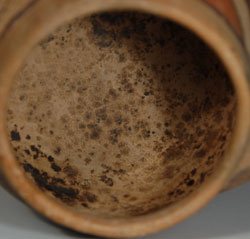Pre-Columbian Paquimé Polychrome Bowl [SOLD]
+ Add to my watchlist Forward to Friend
- Category: Pre-Columbian or Prehistoric
- Origin: Casas Grandes, Mexico
- Medium: clay, pigments
- Size: 4-1/2” deep x 5-3/4” diameter
- Item # C3309A SOLD
 Pueblo peoples are archaeologically identifiable by at least 2000 years and they have continued to live in the greater southwest continuously to the present. Before portions of the greater southwest became part of the United States and other portions became part of Mexico, the Greater Southwest included all of what is today known as California, Arizona, Nevada, Utah, Colorado, New Mexico, Texas, and the states of Mexico known as Sonora and Chihuahua. There were no dividing lines between parts of these lands. There were native villages in all these areas.
Pueblo peoples are archaeologically identifiable by at least 2000 years and they have continued to live in the greater southwest continuously to the present. Before portions of the greater southwest became part of the United States and other portions became part of Mexico, the Greater Southwest included all of what is today known as California, Arizona, Nevada, Utah, Colorado, New Mexico, Texas, and the states of Mexico known as Sonora and Chihuahua. There were no dividing lines between parts of these lands. There were native villages in all these areas.
In the state of Chihuahua, Mexico, there developed a large and bustling pueblo now known as Paquimé just southwest of the present town of Juarez. Between 1100 and 1200, a long drought occurred in the Southwest which eventually resulted in the abandonment of Chaco Canyon and the Mimbres country in southern New Mexico. There were migrations that perhaps ended in Mexico and the establishment of Paquimé, a multistory pueblo that appeared around 1250. Excavations have revealed that it was the largest of all the ancient pueblos. J. Walter Fewkes, head of the Bureau of American Ethnology of the Smithsonian Institution published a report in 1914 with numerous comparisons between Mimbres and Casas Grandes pottery. Pottery found in excavations of Paquimé has been referred to as Casas Grandes pottery, and is dated between 1250 and 1400.
Casas Grandes potters were exceptional potters, leading to the conclusion that other developed peoples moved there and immediately created fine wares. This small bowl is typical in shape and design of those found at Paquimé. It dates to the 1250 to 1400 periods and is in excellent condition. The two handles on opposing sides of the bowl appear to be serpent heads, a theme seen often in their pottery. The black, red, and white decoration consists of large triangles in a simple and elegant design.
Condition: very good condition
Recommended Reading: Casas Grandes and the Ceramic Art of the Ancient Southwest, edited by Richard F. Townsend
Provenance: from the collection of Katherine H. Rust

- Category: Pre-Columbian or Prehistoric
- Origin: Casas Grandes, Mexico
- Medium: clay, pigments
- Size: 4-1/2” deep x 5-3/4” diameter
- Item # C3309A SOLD


